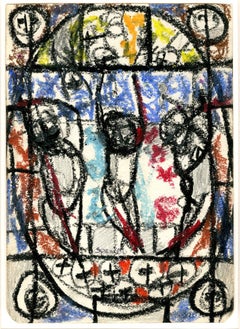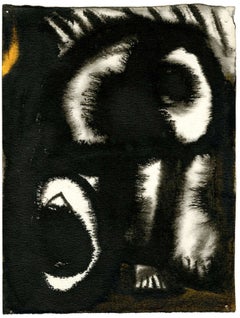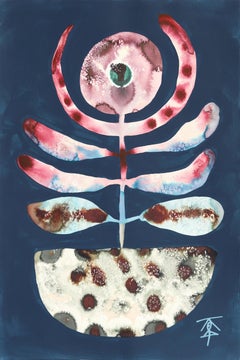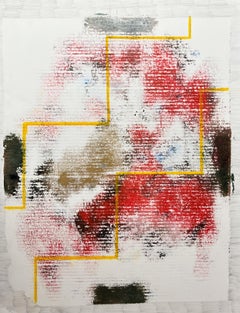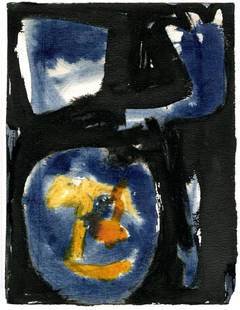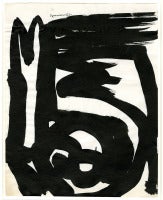Sam Spanier Abstract Drawings and Watercolors
to
3
Overall Width
to
Overall Height
to
3
2
1
3
3
2
2
1
1
1
3
138
110
94
77
3
Artist: Sam Spanier
Chorus Line
By Sam Spanier
Located in Fairlawn, OH
Chorus Line
Oil pastel on paper, c. 1960's
Signed (see photo)
Provenance: Estate of the Artist
Estate of the artist (Estate No. 745)
Condition: Excellent
Image/Sheet size: 5 3/4 x 4 inches
Sam Spanier (1925-2008)
Born in Brooklyn New York, Sam Spanier studied painting with Hans Hofmann (1949–50) and also at the Taos Valley Art School (1951). His formative years as a working artist were spent in Paris (1951–52), where he also became involved with the work of G. I. Gurdjieff, through his disciple, Mme. Jeanne de Salzmann.
By 1953, Spanier’s work had already begun to meet with critical acclaim. That year, he had his first solo gallery show, and was selected by Milton Avery and Hans Hofmann to receive the prestigious Lorian Fund Award. His second solo exhibition, in 1955, was curated by renowned museum director, Gordon Washburn. Spanier’s early work was reviewed by Dore Ashton, Donald Judd, Fairfield Porter, Stuart Preston, and Irving Sandler, among other significant critics of the period.
Spanier’s spiritual path increasingly became the central focus of both his life and his art. In 1960, he was introduced to the teachings of Sri Aurobindo, which led to visits to the Sri Aurobindo Ashram in Pondicherry, India, in 1962 and 1964, during which he was inspired to leave New York City and found Matagiri (in 1968)—a spiritual center in Woodstock, New York—with his lifelong partner, Eric Hughes. The work he embarked upon there bifurcates his life as an artist, separating him from New York’s art world, and radically altering the trajectory of his career. From that point forward, it would be difficult, perhaps impossible, to consider his artistic endeavor apart from the life of dedication he had undertaken, and to which he remained committed.
As early as 1954, Dore Ashton had recognized in Sam Spanier a “haptic visionary;” in 1960, Irving Sandler wrote that the people in Spanier’s paintings “seem to have witnessed some transfiguring event.” In his later paintings—usually worked in oil pastel on panel or paper—made during intermittent creative periods, from the mid-1970s to the final years of his life, the artist’s inner life remains always apparent in his subject matter; and from the portraits and abstract Buddha-like figures and heads, to the fantasy landscapes, the paintings are redolent with a rich intensity of color and light that can only be described as inspired.
Sam Spanier’s works are in the collections of the Historical Society of Woodstock Museum, and the Woodstock Artists Association & Museum. He received the Woodstock Artists Association Lifetime Achievement Award in 2007.
Selected Solo Exhibitions:
Urban Gallery, New York (1954, 1955, 1956); Wittenborn Gallery, New York (1958); Gallery Mayer, New York (1958, 1959, 1960); Unison Gallery, New Paltz (1986, 1995, 2009); Limner Gallery, New York (1988); Fletcher Gallery, Woodstock, New York (1999).
Selected Group Exhibitions:
Salon des Comparaisons, Musée d’Art Moderne, Paris, France (1952); October Exhibition of Oil Paintings, New York City Center Gallery, New York (1954); Salon de Mai, Musée d’Art moderne de la ville de Paris, Centre Culturel de Saint-Germain-en-Laye, Paris, France (1954); Carnegie International, Carnegie Institute, Pittsburgh, Pennsylvania (1955); Les Plus Mauvais Tableaux, Galerie Prismes, Paris (1955);
Première Exposition Internationale de l’Art Plastique Contemporain, Musée des Beaux-Arts de la Ville de Paris (1956); Recent Paintings USA: The Figure, The Museum of Modern Art (1960); Winter’s Work, Woodstock Artists Association, Woodstock, New York (1985); Juried Group Show, Woodstock Artists Association, Woodstock, New York (1986); Woodstock Artists, Self-Portraits, Historical Society of Woodstock Museum, Woodstock, New York (1988); Portraits, Albert Shahinian Fine Art, Poughkeepsie, New York (2003); The World We Live In, Upstate Art, Phoenicia, New York (2003); Show of Heads, Limner Gallery, Phoenicia, New York (2004).
Selected Writings on the Artist:
Dore Ashton, “Sam Spanier,” Art Digest (May 1, 1954) and “Sam Spanier,” The New York Times (March 16, 1960); Cassia Berman, “Sam Spanier: A Divine Calling,” Woodstock Times (February 7, 2008); Lawrence Campbell, “Sam Spanier: Exhibition of Paintings at Urban Gallery,” Art News (April 1, 1954); Sam Feinstein...
Category
1960s Abstract Sam Spanier Abstract Drawings and Watercolors
Materials
Oil Crayon
Black and White Cat
By Sam Spanier
Located in Fairlawn, OH
Black and White Cat
Ink and watercolor on paper, c. 1970
Unsigned
Provenance:
Estate of the artist (Estate No. 737)
Condition: Excellent
Image/Sheet size: 4 3/4 x 6 1/4 inches
Sam Spanier (1925-2008)
Born in Brooklyn New York, Sam Spanier studied painting with Hans Hofmann (1949–50) and also at the Taos Valley Art School (1951). His formative years as a working artist were spent in Paris (1951–52), where he also became involved with the work of G. I. Gurdjieff, through his disciple, Mme. Jeanne de Salzmann.
By 1953, Spanier’s work had already begun to meet with critical acclaim. That year, he had his first solo gallery show, and was selected by Milton Avery and Hans Hofmann to receive the prestigious Lorian Fund Award. His second solo exhibition, in 1955, was curated by renowned museum director, Gordon Washburn. Spanier’s early work was reviewed by Dore Ashton, Donald Judd, Fairfield Porter, Stuart Preston, and Irving Sandler, among other significant critics of the period.
Spanier’s spiritual path increasingly became the central focus of both his life and his art. In 1960, he was introduced to the teachings of Sri Aurobindo, which led to visits to the Sri Aurobindo Ashram in Pondicherry, India, in 1962 and 1964, during which he was inspired to leave New York City and found Matagiri (in 1968)—a spiritual center in Woodstock, New York—with his lifelong partner, Eric Hughes. The work he embarked upon there bifurcates his life as an artist, separating him from New York’s art world, and radically altering the trajectory of his career. From that point forward, it would be difficult, perhaps impossible, to consider his artistic endeavor apart from the life of dedication he had undertaken, and to which he remained committed.
As early as 1954, Dore Ashton had recognized in Sam Spanier a “haptic visionary;” in 1960, Irving Sandler wrote that the people in Spanier’s paintings “seem to have witnessed some transfiguring event.” In his later paintings—usually worked in oil pastel on panel or paper—made during intermittent creative periods, from the mid-1970s to the final years of his life, the artist’s inner life remains always apparent in his subject matter; and from the portraits and abstract Buddha-like figures and heads, to the fantasy landscapes, the paintings are redolent with a rich intensity of color and light that can only be described as inspired.
Sam Spanier’s works are in the collections of the Historical Society of Woodstock Museum, and the Woodstock Artists Association & Museum. He received the Woodstock Artists Association Lifetime Achievement Award in 2007.
Selected Solo Exhibitions:
Urban Gallery, New York (1954, 1955, 1956); Wittenborn Gallery, New York (1958); Gallery Mayer, New York (1958, 1959, 1960); Unison Gallery, New Paltz (1986, 1995, 2009); Limner Gallery, New York (1988); Fletcher Gallery, Woodstock, New York (1999).
Selected Group Exhibitions:
Salon des Comparaisons, Musée d’Art Moderne, Paris, France (1952); October Exhibition of Oil Paintings, New York City Center Gallery, New York (1954); Salon de Mai, Musée d’Art moderne de la ville de Paris, Centre Culturel de Saint-Germain-en-Laye, Paris, France (1954); Carnegie International, Carnegie Institute, Pittsburgh, Pennsylvania (1955); Les Plus Mauvais Tableaux, Galerie Prismes, Paris (1955);
Première Exposition Internationale de l’Art Plastique Contemporain, Musée des Beaux-Arts de la Ville de Paris (1956); Recent Paintings USA: The Figure, The Museum of Modern Art (1960); Winter’s Work, Woodstock Artists Association, Woodstock, New York (1985); Juried Group Show, Woodstock Artists Association, Woodstock, New York (1986); Woodstock Artists, Self-Portraits, Historical Society of Woodstock Museum, Woodstock, New York (1988); Portraits, Albert Shahinian Fine Art, Poughkeepsie, New York (2003); The World We Live In, Upstate Art, Phoenicia, New York (2003); Show of Heads, Limner Gallery, Phoenicia, New York (2004).
Selected Writings on the Artist:
Dore Ashton, “Sam Spanier,” Art Digest (May 1, 1954) and “Sam Spanier,” The New York Times (March 16, 1960); Cassia Berman, “Sam Spanier: A Divine Calling,” Woodstock Times (February 7, 2008); Lawrence Campbell, “Sam Spanier: Exhibition of Paintings at Urban Gallery,” Art News...
Category
1970s Abstract Sam Spanier Abstract Drawings and Watercolors
Materials
Ink, Watercolor
Chorus Line
By Sam Spanier
Located in Fairlawn, OH
Chorus Line
Oil pastel on paper, c. 1960's
Signed (see photo)
Provenance: Estate of the Artist
Estate of the artist (Estate No. 745)
Condition: Excellent
Image/Sheet size: 5 3/4 x 4 inches
Sam Spanier (1925-2008)
Born in Brooklyn New York, Sam Spanier studied painting with Hans Hofmann (1949–50) and also at the Taos Valley Art School (1951). His formative years as a working artist were spent in Paris (1951–52), where he also became involved with the work of G. I. Gurdjieff, through his disciple, Mme. Jeanne de Salzmann.
By 1953, Spanier’s work had already begun to meet with critical acclaim. That year, he had his first solo gallery show, and was selected by Milton Avery and Hans Hofmann to receive the prestigious Lorian Fund Award. His second solo exhibition, in 1955, was curated by renowned museum director, Gordon Washburn. Spanier’s early work was reviewed by Dore Ashton, Donald Judd, Fairfield Porter, Stuart Preston, and Irving Sandler, among other significant critics of the period.
Spanier’s spiritual path increasingly became the central focus of both his life and his art. In 1960, he was introduced to the teachings of Sri Aurobindo, which led to visits to the Sri Aurobindo Ashram in Pondicherry, India, in 1962 and 1964, during which he was inspired to leave New York City and found Matagiri (in 1968)—a spiritual center in Woodstock, New York—with his lifelong partner, Eric Hughes. The work he embarked upon there bifurcates his life as an artist, separating him from New York’s art world, and radically altering the trajectory of his career. From that point forward, it would be difficult, perhaps impossible, to consider his artistic endeavor apart from the life of dedication he had undertaken, and to which he remained committed.
As early as 1954, Dore Ashton had recognized in Sam Spanier a “haptic visionary;” in 1960, Irving Sandler wrote that the people in Spanier’s paintings “seem to have witnessed some transfiguring event.” In his later paintings—usually worked in oil pastel on panel or paper—made during intermittent creative periods, from the mid-1970s to the final years of his life, the artist’s inner life remains always apparent in his subject matter; and from the portraits and abstract Buddha-like figures and heads, to the fantasy landscapes, the paintings are redolent with a rich intensity of color and light that can only be described as inspired.
Sam Spanier’s works are in the collections of the Historical Society of Woodstock Museum, and the Woodstock Artists Association & Museum. He received the Woodstock Artists Association Lifetime Achievement Award in 2007.
Selected Solo Exhibitions:
Urban Gallery, New York (1954, 1955, 1956); Wittenborn Gallery, New York (1958); Gallery Mayer, New York (1958, 1959, 1960); Unison Gallery, New Paltz (1986, 1995, 2009); Limner Gallery, New York (1988); Fletcher Gallery, Woodstock, New York (1999).
Selected Group Exhibitions:
Salon des Comparaisons, Musée d’Art Moderne, Paris, France (1952); October Exhibition of Oil Paintings, New York City Center Gallery, New York (1954); Salon de Mai, Musée d’Art moderne de la ville de Paris, Centre Culturel de Saint-Germain-en-Laye, Paris, France (1954); Carnegie International, Carnegie Institute, Pittsburgh, Pennsylvania (1955); Les Plus Mauvais Tableaux, Galerie Prismes, Paris (1955);
Première Exposition Internationale de l’Art Plastique Contemporain, Musée des Beaux-Arts de la Ville de Paris (1956); Recent Paintings USA: The Figure, The Museum of Modern Art (1960); Winter’s Work, Woodstock Artists Association, Woodstock, New York (1985); Juried Group Show, Woodstock Artists Association, Woodstock, New York (1986); Woodstock Artists, Self-Portraits, Historical Society of Woodstock Museum, Woodstock, New York (1988); Portraits, Albert Shahinian Fine Art, Poughkeepsie, New York (2003); The World We Live In, Upstate Art, Phoenicia, New York (2003); Show of Heads, Limner Gallery, Phoenicia, New York (2004).
Selected Writings on the Artist:
Dore Ashton, “Sam Spanier,” Art Digest (May 1, 1954) and “Sam Spanier,” The New York Times (March 16, 1960); Cassia Berman, “Sam Spanier: A Divine Calling,” Woodstock Times (February 7, 2008); Lawrence Campbell, “Sam Spanier: Exhibition of Paintings at Urban Gallery,” Art News (April 1, 1954); Sam Feinstein, “Sam Spanier: Exhibition of Paintings at Urban Gallery,” Art Digest (March 1, 1955); Pat Horner, “Big Heart, Timeless Art —Sam Spanier Retrospective at Fletcher Gallery, Woodstock Times (July 1, 1999); Donald Judd, “In the Galleries: Sam Spanier,” Arts Magazine (April 1960); Liam Nelson, “Human Force...
Category
1960s Abstract Sam Spanier Abstract Drawings and Watercolors
Materials
Oil Crayon
Related Items
Flower in Bowl - Abstract Cool Tone Botanical Mixed Media Painting on Paper
Located in Los Angeles, CA
Krisanne Souter weaves together elements of nature and ancient feminine archetypes, such as the Mother and the Mystic. Botanical themes, playful elements, and unexpected surprises ar...
Category
21st Century and Contemporary Abstract Sam Spanier Abstract Drawings and Watercolors
Materials
Paper, Ink, Acrylic, Watercolor, Color Pencil
Colorful painting on paper, Unique piece, Abstract Expressionist
Located in Carballo, ES
TUSET (1997, A Coruña, España)
Mixed media painting on paper
Ready to frame
One-of-a-kind
Signed on back
Includes certificate of authenticity
2021
65 x 50 cm.
It belongs to the ser...
Category
21st Century and Contemporary Abstract Geometric Sam Spanier Abstract Drawings and Watercolors
Materials
Paper, Oil Crayon, Ink, Mixed Media, Acrylic, Pencil
$719
H 65 in W 50 in D 0.2 in
Flow
Located in San Francisco, CA
Paula Valenzuela
Flow, 2025
Watercolor, alcohol and acrylic ink on paper
14 x 10 inches
This one-of-a-kind work on paper comes unframed and ships in a tube. External, visible frame ...
Category
21st Century and Contemporary Abstract Sam Spanier Abstract Drawings and Watercolors
Materials
Paper, Ink, Watercolor
Botanical Experiment #1
Located in San Francisco, CA
Paula Valenzuela
Botanical Experiment #1, 2025
Alcohol and watercolor inks on Yupo paper
14 x 11 inches
This one-of-a-kind work on paper comes unframed and ships in a tube. External...
Category
21st Century and Contemporary Abstract Sam Spanier Abstract Drawings and Watercolors
Materials
Paper, Ink, Watercolor
"American Bald Eagle Flying Through Silver Clouds Between..." by David Barnett
By David Barnett
Located in Milwaukee, WI
"American Bald Eagle Flying Through Silver Clouds Between Heaven and Earth" is an original mixed media piece by David Barnett, signed on the lower left center. It incorporates watercolor, ink, iridescent acrylic, rubber stamps, collage, and oil pencil. This piece depicts a surrealist landscape. A cow with an cowl perched on its back stands in the lower left corner, and tracks lead away from it across the bottom of the picture. A small turtle approaches a pond in the lower right. In the center register of the image, two leaves have been collaged into an abstractly-drawn forest. The eagle of the title is shown in several stages of its flight through the blue and yellow sky.
Art size: 7 15/16" x 9 1/2"
Frame size: 15 1/4" x 16 1/8"
David Barnett, an artist, collector, appraiser and gallerist has been passionate about art from the early age of five. David’s career as an art dealer began at age nineteen when, as a fine arts student, he sponsored an exhibition of work by fellow student artists. In 1966, he opened his first gallery in a converted basement apartment at Wisconsin Avenue and 21st Street. David’s talents for recognizing undervalued artists and for meeting the needs of art lovers, art collectors and artists have created a vibrant, flourishing gallery and collection of over 6,000 works of art.
David was born and raised in Wisconsin. He has been painting in watercolors, acrylics, oil pastels as well as fine art photography. David has more than 10 different series he has developed over the years. They include Abstract, Surrealism, Morph Dog, Up North Birch Bark, Impressions of Mexico City, Southwest, Fireworks, Famous Artist Paying Homage and Garden Panorama. Influential artists include Vermeer, Miro, Kandinsky, Chagall, Nolde and Klee. David has been featured in many magazines, newspapers and public television programs regarding his beautiful gallery, collection and knowledge and passion of fine art. David also has work in the permanent collection Scottsdale Museum of Contemporary Art, Arizona.
Exhibits
“Morph Dog Series”, David Barnett Gallery, 1996
“Renewal", Art Escape Gallery, Thiensville, WI, 2003
“Recent Watercolors", David Barnett Gallery, 2003,
Lora D. Art Gallery, Chicago, IL, 2004
“Group Show”, Broden Gallery Ltd., Madison, WI, May-June 2004
"Homage to Kandinsky", David Barnett Gallery, Milwaukee, WI 2014
Collections Scottsdale Museum of Contemporary Art, Scottsdale, AZ
Private collections throughout the United States and around the world including collections in Wisconsin, Maryland, New York, Washington D.C., Arizona, Illinois, Florida, Kentucky. International collections in Brazil, Singapore and Hong Kong.
Articles Milwaukee Journal Sentinel, "Barnett Gives His Work an Exhibit" by James Auer, November 1996 Exclusively Yours...
Category
2010s Contemporary Sam Spanier Abstract Drawings and Watercolors
Materials
Oil Crayon, Ink, Mixed Media, Acrylic, Watercolor, Other Medium
$1,890
H 15.25 in W 13.125 in
Living Heart
Located in San Francisco, CA
Paula Valenzuela
Living Heart, 2025
Watercolor and acrylic inks on paper
12 x 9 inches
This one-of-a-kind work on paper comes unframed and ships in a tube. External, visible frame a...
Category
21st Century and Contemporary Abstract Sam Spanier Abstract Drawings and Watercolors
Materials
Paper, Ink, Watercolor
Study for Scissors Jack Series, colored ink drawing hand signed geometric framed
By Larry Zox
Located in New York, NY
Larry Zox
Study for Scissors Jack Series, 1965
Mixed media and colored ink drawing on draft paper
Hand signed and dated on lower right recto (front). Bears Forager House Collection s...
Category
1960s Abstract Geometric Sam Spanier Abstract Drawings and Watercolors
Materials
Oil Crayon, Ink, Color Pencil
$5,500
H 11.25 in W 14.25 in D 0.5 in
Living Roots
Located in San Francisco, CA
Paula Valenzuela
Living Roots, 2025
Watercolor and acrylic inks on translucent Yupo paper
12 x 9 inches
This one-of-a-kind work on translucent paper comes unframed and ships in a tu...
Category
21st Century and Contemporary Abstract Sam Spanier Abstract Drawings and Watercolors
Materials
Paper, Ink, Watercolor
Abstract Expressionist British Original Watercolor Painting Provence France
By Robert Somerton
Located in Cirencester, Gloucestershire
Abstract Composition (c.2022)
by Robert Somerton, British, born 1972.
ink/ watercolor on art paper, unframed
size: 9.5 x 12.5 inches
condition: excellent
Category
2010s Abstract Expressionist Sam Spanier Abstract Drawings and Watercolors
Materials
Ink, Watercolor
$523 Sale Price
49% Off
H 9.5 in W 12.5 in D 0.1 in
Untitled (magenta and orange)
By Anastasia Pelias
Located in New Orleans, LA
ANASTASIA PELIAS was born in New Orleans, LA to Greek parents. Her artistic practice is rooted in the dual cultural identity of both her native and ancestral roots in New Orleans, LA...
Category
21st Century and Contemporary Contemporary Sam Spanier Abstract Drawings and Watercolors
Materials
Paper, Oil Crayon
Abstract Expressionist British Original Watercolor Painting Shapes Patterns
By Robert Somerton
Located in Cirencester, Gloucestershire
Abstract Composition (c.2022)
by Robert Somerton, British, born 1972.
ink/ watercolor on art paper, unframed
size: 12.5 x 9.5 inches
condition: excellent
Category
2010s Abstract Expressionist Sam Spanier Abstract Drawings and Watercolors
Materials
Ink, Watercolor
$384 Sale Price
62% Off
H 12.5 in W 9.5 in D 0.1 in
Abstract composition - acrylic on paper in beige, gray, pink salmon color, 2023
By Mila Akopova
Located in Fort Lee, NJ
Interior design paintings. The work was done with acrylic in beige, pink salmon and grey color on a paper. Each work is 24 by 18 inches in size, framed (gold).
Mila Akopova is New Y...
Category
2010s Abstract Geometric Sam Spanier Abstract Drawings and Watercolors
Materials
Paper, Oil Crayon, Acrylic
$1,440 Sale Price
20% Off
H 24 in W 36 in
Previously Available Items
Burning Ember
By Sam Spanier
Located in Fairlawn, OH
Estate of the artist (Estate No. 736)
Category
20th Century Sam Spanier Abstract Drawings and Watercolors
Materials
Ink, Watercolor
Whoosh!
By Sam Spanier
Located in Fairlawn, OH
Signed and dated in ink upper center
Provenance:
Estate of the artist (Estate No. 744)
Category
1950s Sam Spanier Abstract Drawings and Watercolors
Materials
Ink, Paper
Sam Spanier abstract drawings and watercolors for sale on 1stDibs.
Find a wide variety of authentic Sam Spanier abstract drawings and watercolors available for sale on 1stDibs. You can also browse by medium to find art by Sam Spanier in crayon, ink, oil crayon and more. Much of the original work by this artist or collective was created during the 20th century and is mostly associated with the abstract style. Not every interior allows for large Sam Spanier abstract drawings and watercolors, so small editions measuring 4 inches across are available. Customers who are interested in this artist might also find the work of Michael Knigin, Macyn Bolt, and Emily Berger. Sam Spanier abstract drawings and watercolors prices can differ depending upon medium, time period and other attributes. On 1stDibs, the price for these items starts at $700 and tops out at $750, while the average work can sell for $725.
